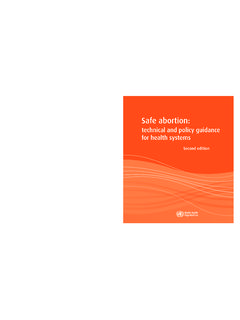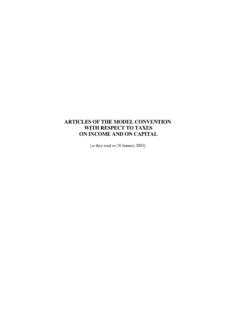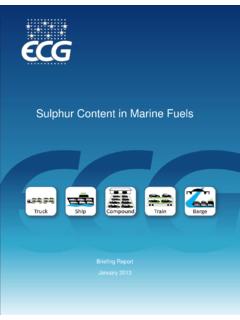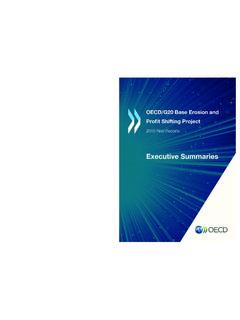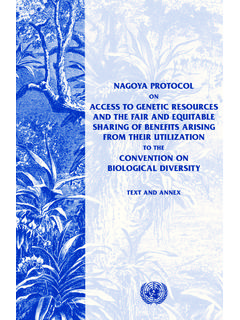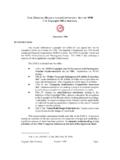Transcription of Nordic Council of Ministers - WHO
1 Nordic Council of Ministers Cadmium Review January 2003 Nordic Council of Ministers Cadmium Review January 2003 Report no. 1 Issue no. 04 Date of issue 28. January 2003 Prepared CRL, EHN Cadmium Review C:\Documents and Settings\crl\Local Settings\Temporary Internet Files\OLK46\No- Cadmium Review 1 . Table of Contents 1 Introduction 2 2 summary 3 3 General Description 5 Global Production 5 End Uses 6 4 Environmental Exposure and Effects 8 Sources and Emissions 8 Environmental Effects 11 5 Human Exposure and Health Effects 14 Human Exposure 14 Health Effects 15 6 International Regulation 16 International Conventions and Treaties 16 Legislation 17 Other
2 Regulations 18 7 Substitution 20 8 Literature 22 Cadmium Review C:\Documents and Settings\crl\Local Settings\Temporary Internet Files\OLK46\No- Cadmium Review 2 . 1 Introduction This document aims to present a brief overview of the heavy metal cadmium. The overview deals with the issues of production, consumption and emissions, the exposure, health and environmental impacts, regulations and substitutes to the use of cadmium. The document is prepared as a background paper to the meeting in UNEP Gov-erning Council in February 2003.
3 The objective of the document is to evaluate cadmium as a global pollutant and provide a background for a request from the Nordic Countries to consider cadmium a potential candidate for global initia-tives parallel to the initiatives currently being considered for mercury. The document is based on available literature including reports, scientific arti-cles and databases. The document does, however, not claim to be an exhaustive presentation covering all relevant issues in full detail. This report has been prepared by COWI A/S on behalf of the Nordic Council of Ministers . Cadmium Review C:\Documents and Settings\crl\Local Settings\Temporary Internet Files\OLK46\No- Cadmium Review 3.
4 2 summary Cadmium is a heavy metal with a high toxicity. Cadmium is toxic at very low exposure levels and has acute and chronic effects on health and environment. Cadmium is not degradable in nature and will thus, once released to the envi-ronment, stay in circulation. New releases add to the already existing deposits of cadmium in the environment. Cadmium and cadmium compounds are, com-pared to other heavy metals, relatively water soluble. They are therefore also more mobile in soil, generally more bioavailable and tend to bioaccumu-late. Chronic cadmium exposure produces a wide variety of acute and chronic ef-fects in humans.
5 Cadmium accumulates in the human body and especially in the kidneys. According to the current knowledge kidney damage (renal tubular damage) is probably the critical health effect. Other effects of cadmium expo-sure are disturbances of calcium metabolism, hypercalciuria and formation of stones in the kidney. High exposure can lead to lung cancer and prostate cancer. The major issues of concern related to cadmium may be summarised as fol-lows: Atmospheric deposition seems continuously to cause the content of cadmium in agricultural top soil to increase, which by time will be re-flected in an increased human intake by foodstuffs and therefore in an increased human risk of kidney damages and other effects related to cadmium.
6 In the marine environment levels of cadmium may significantly exceed background levels causing a potential for serious effects on marine animals and in particular birds and mammals. Significant quantities of cadmium are continuously stockpiled in land-fills and other deposits and represent a significant potential for future releases to the environment. The dominant sources of atmospheric emission will vary depending on the re-gion or country considered. Non-ferrous metal production as well as combus-tion of coal and oil and waste incineration should be considered important sources. Important sources of cadmium input to the marine environment in-clude atmospheric deposition, domestic waste water and industrial discharges.
7 Emissions to air as well as water on an international scale seem to be lowering due to improved flue gas and waste water treatment. Long range transport of cadmium by air is reflected in ice cores from Greenland. Emissions from Eurasia and North America must be considered im-portant sources for cadmium to the Arctic Region. Cadmium Review C:\Documents and Settings\crl\Local Settings\Temporary Internet Files\OLK46\No- Cadmium Review 4 . The environmental fate and the toxicity of cadmium calls for a global initiative aimed at minimising human and environmental consequences of the ongoing cadmium emissions. The relevance of considering a global initiative comes, furthermore, from the fact that cadmium used intentionally in products is traded globally and that effective risk reduction measures thus must be seen in a global context.
8 Global efforts addressing cadmium may include a phase-out of cadmium in products as well as global agreements of improved emission control related to air as well as water emissions. Adequate substitutes exist for many applications for which cadmium is still being used. The current low world market price of cadmium motivates the development of new applications that by time may develop into new sources of emissions to the environment not covered by existing regulation. Cadmium Review C:\Documents and Settings\crl\Local Settings\Temporary Internet Files\OLK46\No- Cadmium Review 5 . 3 General Description Global Production Cadmium is produced mainly as a by-product from mining, smelting, and refin-ing sulphide ores of zinc, and to a lesser degree, lead and copper.
9 Cadmium minerals do not occur in concentrations and quantities sufficient to justify min-ing them in their own right. As it is a by-product of zinc, the production of cad-mium is more dependent on zinc refining than on market demand /OECD 1994/. The percentage of cadmium in zinc concentrates varies from mine to mine, ranging from to per cent with an average of per cent. Small amounts of cadmium, about 10-15% of consumption, are produced from secondary sources, mainly from dust generated by recycling of iron and steel scrap. /OECD 1994/ The global cadmium production increased with a factor of four from 1950 to 1990 (Figure ).
10 In the recent decade the production has slightly decreased. Figure Global cadmium refinery production 1950-2000 /USGS 2002b/ Mine production and reserves by country is shown in table The reserves are estimated at 600,000 tonnes resembling 30 years production at today level. Estimated world resources of cadmium were about 6 million tons based on zinc resources containing about cadmium /USGS 2002a/. Zinc-bearing coals also contain large sub-economic resources of cadmium. Cadmium Review C:\Documents and Settings\crl\Local Settings\Temporary Internet Files\OLK46\No- Cadmium Review 6 . Table Mine production and reserves by country, 2000/2001 /USGS 2002a/ Country Mine production 2000 Tonnes Reserves 1)










